
According to NASA, the air indoors is as much as 30 times more toxic than the air outside.
During the winter months in a pandemic, this is a problem.
One solution, borne out by NASA research, is to bring some of the outside in: plants and associated microorganisms in the soil around them are “nature’s life-support system,” notes a study published by Stennis Space Center in 1989.
The study, led by B.C. Wolverton, head of Stennis’ Environmental Research Lab, was interested in how to maximize the air-scrubbing ability of plants. After all, space habitats present the toughest possible challenge for ensuring safe, breathable air, since they’re entirely closed systems in an airless vacuum. There’s no chance to get some fresher air by opening a window, and even if engineers were able to build a habitat free from any of the toxins and chemical pollutants we find on Earth, “man’s own waste products would cause indoor air pollution problems,” notes Wolverton.
Wolverton screened a dozen common houseplants from the gerbera daisy to the bamboo palm, and tested their ability to remove a variety of household toxins, like formaldehyde, from a sealed chamber. The goal was to find which plants did the best job with different pollutants.
“Plant roots and their associated microorganisms then destroy the pathogenic viruses, bacteria, and the organic chemicals, eventually converting all these air pollutants into new plant tissue,” according to the study.
“There are a lot of articles describing the air-purifying plants used by NASA,” explains founder and managing director Peer-Arne Bottcher; anyone can use those plants in their home.
In these chilly winter months, it’s easy to be cooped up indoors for hours without a breath of fresh air. Dust, mold, and bacteria build up, while every day cleaning products, paints, and plastics emit formaldehyde and benzene into our poorly ventilated homes. Stale air, allergies and asthma can result as our tightly sealed homes keep the warmth inside, but also prevent fresh air from entering.
Local experts at McArdle’s say plants can improve the air quality in your home as well as your mood.
“Our indoor spaces always feel a little empty after the holiday decor comes down,” they said, “try adding a few fresh green houseplants to the rooms where your family spends the most time.
Here are some tips from McArdle’s (McArdles.com) for successful house plants:
Know Your Light
A common mistake is not knowing how much light you have. If you have windows on multiple sides of the room that aren’t shaded by trees & buildings, you’ve got “direct sun” or “bright-indirect light”. You’ll know a “direct sun” room because it likely gets warm from the amount of sunlight. If you have a window on just one side of the room, or the windows are partly shaded, you’re working with “low light” in most of the room and “bright-indirect light” only in the few feet of space directly in front of the window.
Most indoor plants prefer what is called “bright-indirect light”– a room where you can read by daylight until the sun sets. If you prefer a lamp on during the day in certain areas of a room, those areas have “low light”.
Don’t Over Water
My favorite tip for new plant parents is not to over-water! It’s way easier for a plant to bounce back from being a little dry than it is for them to recover from being a muddy, moldy mess. Whenever you want to water your plant, always check the soil about one or two inches down with your finger. If the soil feels cool and damp, more water is not necessary or beneficial. The soil will tell you when it’s time to water.
Fortunately, plants provide “nature’s life support system,” filtering out the toxins in our air, so that we don’t have to breathe them. While all plants will help to clean the air inside your home or office, these plants are real superstars when it comes to removing toxins.
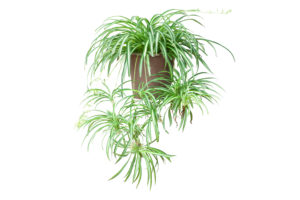
SPIDER PLANT (CHLOROPHYTUM COMOSUM)
Easy to grow and maintain
Removes xylene, formaldehyde, carbon dioxide
Best in bright, indirect sunlight
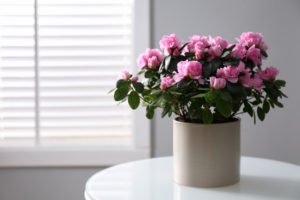 AZALEA
AZALEA
Removes formaldehyde
Thrives in cool temperatures
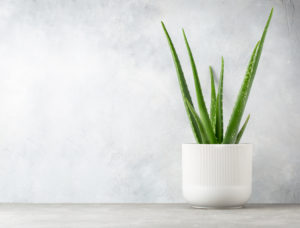 ALOE (ALOE VERA)
ALOE (ALOE VERA)
Removes formaldehyde and benzene
Aloe contains vitamins, enzymes, and amino acids that heal cuts and wounds!
Loves the sun
 BAMBOO PALM (CHAMAEDOREA SEIFRITZII)
BAMBOO PALM (CHAMAEDOREA SEIFRITZII)
Removes formaldehyde, benzene, trichloroethylene
Can grow to 4 -12 feet tall
Prefers bright, indirect light
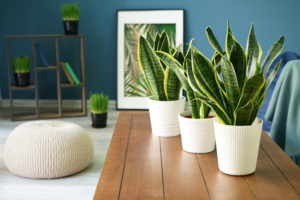 SNAKE PLANT (SANSEVIERIA TRIFASCIATA)
SNAKE PLANT (SANSEVIERIA TRIFASCIATA)
Removes xylene, benzene, formaldehyde, trichloroethylene
Prefers direct sun
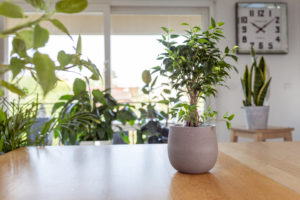
WEEPING FIG (FICUS BENJAMINA)
Removes benzene, formaldehyde, trichloroethylene
Grows up to 10 feet tall
Best in bright, indirect light
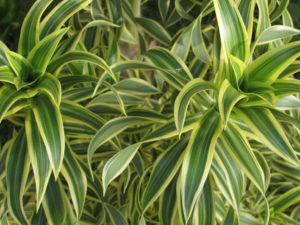 DRACENA
DRACENA
Over 40 beautiful varieties to fit in any decor
Removes benzene, formaldehyde, trichloroethylene, and xylene
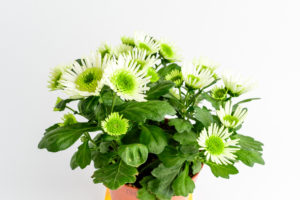 GARDEN MUM CHRYSANTHEMUM MORIFOLIUM)
GARDEN MUM CHRYSANTHEMUM MORIFOLIUM)
Mums the word
Removes ammonia, xylene, formaldehyde, benzene
thrives in bright light and can be transferred outdoors
Comes in a variety of colorful blooms to brighten up any room
Pick up some house plants and improve your air quality as well as your mental health.




